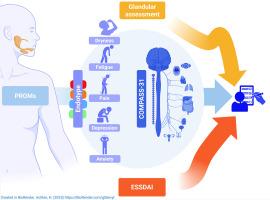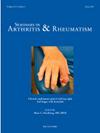Sjögren疾病中的自主神经功能障碍症状:与疾病负担和工作残疾相关的缺失维度
IF 4.4
2区 医学
Q1 RHEUMATOLOGY
引用次数: 0
摘要
背景:自主神经功能障碍(AD)在Sjögren's Disease (SjD)中已有报道,但其与既定客观和患者报告的结果测量(PROMs)的关系尚不清楚。目的:主要目的是评估大型SjD队列中的AD症状,并检查其与既定SjD结局指标的关系。其次,评估AD症状与基于症状的内型、工作残疾和阴道干燥之间的关系。方法:来自比利时Sjögren综合征过渡试验的266例SjD患者完成了综合自主神经症状评分31 (COMPASS-31)。客观测量包括腺体受累(超声、焦点评分、sicca试验)和全身性疾病活动性(欧洲风湿病协会联盟(EULAR) Sjögren综合征疾病活动性指数)。PROMs包括EULAR患者报告指数、医院焦虑抑郁量表、修正疲劳影响量表、阴道干燥和职业。纽卡斯尔Sjögren的分层工具将患者分为“低症状负担”,“干燥主导疲劳”,“疼痛主导疲劳(PDF)”和“高症状负担(HSB)”。结果:COMPASS-31与客观测量无相关性,但与焦虑(ρ = 0.41)、抑郁(ρ = 0.44)、疼痛(ρ = 0.35)、干燥(ρ = 0.29)和疲劳(ρ = 0.37)有显著相关性(p < 0.001)。将这些PROMS整合到基于症状的内分型中,COMPASS-31在HSB和PDF中的表达最高(p < 0.001)。COMPASS-31独立预测工作能力丧失(OR 2.10, 95% CI 1.29-3.44, p < 0.01),绝经前阴道干燥女性的COMPASS-31预测能力更高(p < 0.01)。结论:阿尔茨海默病的症状没有被确定的结果测量捕获,但有意义地导致疾病负担和工作残疾。COMPASS-31可以作为一个有价值的补充PROM。今后的研究应使阿尔茨海默病客观化,阐明其病理生理机制。本文章由计算机程序翻译,如有差异,请以英文原文为准。

Autonomic dysfunction symptoms in Sjögren’s Disease: A missed dimension linked to disease burden and work disability
Background
Autonomic dysfunction (AD) has been reported in Sjögren’s Disease (SjD), but its relationship with established objective and patient-reported outcome measures (PROMs) is unclear.
Objectives
The primary aim was to assess AD symptoms in a large SjD cohort and to examine their association with established SjD outcome measures. Secondary, the relationship between AD symptoms and symptom-based endotypes, work disability, and vaginal dryness was evaluated.
Methods
The Composite Autonomic Symptom Score 31 (COMPASS-31) was completed by 266 SjD patients from the Belgian Sjögren’s Syndrome Transition Trial. Objective measures included glandular involvement (ultrasound, focus score, sicca tests) and systemic disease activity (European Alliance of Associations for Rheumatology (EULAR) Sjögren’s Syndrome Disease Activity Index). PROMs included EULAR patient reported index, Hospital Anxiety and Depression scale, modified fatigue Impact scale, vaginal dryness and profession. The Newcastle Sjögren’s Stratification Tool stratified patients into 'Low Symptom Burden', 'Dryness Dominant with Fatigue', 'Pain Dominant with Fatigue (PDF)' and 'High Symptom Burden (HSB)'.
Results
COMPASS-31 did not correlate with objective measures, but showed significant associations with anxiety (ρ = 0.41), depression (ρ = 0.44), pain (ρ = 0.35), dryness (ρ = 0.29) and fatigue (ρ = 0.37), (p < 0.001). Integrating these PROMS into symptom-based endotypes, COMPASS-31 was highest in HSB and PDF (p < 0.001). COMPASS-31 independently predicted work disability (OR 2.10, 95 % CI 1.29–3.44, p < 0.01) and was higher in premenopausal women with vaginal dryness (p < 0.01).
Conclusion
AD symptoms are not captured by established outcome measures but meaningfully contribute to disease burden and work disability. COMPASS-31 may serve as a valuable complementary PROM. Future studies should objectify AD and clarify its pathophysiology.
求助全文
通过发布文献求助,成功后即可免费获取论文全文。
去求助
来源期刊
CiteScore
9.20
自引率
4.00%
发文量
176
审稿时长
46 days
期刊介绍:
Seminars in Arthritis and Rheumatism provides access to the highest-quality clinical, therapeutic and translational research about arthritis, rheumatology and musculoskeletal disorders that affect the joints and connective tissue. Each bimonthly issue includes articles giving you the latest diagnostic criteria, consensus statements, systematic reviews and meta-analyses as well as clinical and translational research studies. Read this journal for the latest groundbreaking research and to gain insights from scientists and clinicians on the management and treatment of musculoskeletal and autoimmune rheumatologic diseases. The journal is of interest to rheumatologists, orthopedic surgeons, internal medicine physicians, immunologists and specialists in bone and mineral metabolism.

 求助内容:
求助内容: 应助结果提醒方式:
应助结果提醒方式:


